| Listing 1 - 10 of 44 | << page >> |
Sort by
|
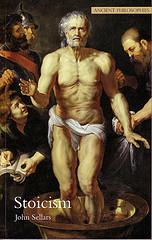
ISBN: 9781844650538 1844650537 9781844650521 1844650529 9781315712093 9781317493891 9781317493907 Year: 2006 Volume: 1
Abstract | Keywords | Export | Availability | Bookmark
 Loading...
Loading...Choose an application
- Reference Manager
- EndNote
- RefWorks (Direct export to RefWorks)
History of philosophy --- Philosophes du Portique --- Philosophes stoïciens --- Philosophie du Portique --- Philosophie stoïcienne --- Portique (Philosophie grecque) --- Portique [Le ] (Ecole philosophique ancienne) --- Stoa (Filosofische school) --- Stoicism --- Stoics --- Stoïciens --- Stoïcijnen --- Stoïcisme --- Stoïcisme (Philosophie grecque) --- École du Portique --- École stoïcienne --- Stoics.
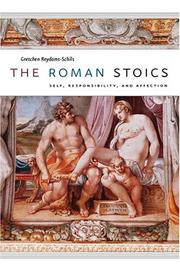
ISBN: 0226308375 9780226710266 9780226308371 Year: 2005
Abstract | Keywords | Export | Availability | Bookmark
 Loading...
Loading...Choose an application
- Reference Manager
- EndNote
- RefWorks (Direct export to RefWorks)
Roman Stoic thinkers in the imperial period adapted Greek doctrine to create a model of the self that served to connect philosophical ideals with traditional societal values. The Roman Stoics-the most prominent being Marcus Aurelius-engaged in rigorous self-examination that enabled them to integrate philosophy into the practice of living. Gretchen Reydams-Schils's innovative new book shows how these Romans applied their distinct brand of social ethics to everyday relations and responsibilities. 'The Roman Stoics' reexamines the philosophical basis that instructed social practice in friendship, marriage, parenting, and community. From this analysis emerge Stoics who were neither cold nor detached, as the stereotype has it, but all too aware of their human weaknesses. In a valuable contribution to current discussions in the humanities on identity, autonomy, and altruism, Reydams-Schils ultimately conveys the wisdom of Stoics to the citizens of modern society.
Philosophes du Portique --- Philosophes stoïciens --- Philosophie du Portique --- Philosophie stoïcienne --- Portique (Philosophie grecque) --- Portique [Le ] (Ecole philosophique ancienne) --- Stoa (Filosofische school) --- Stoicism --- Stoics --- Stoïciens --- Stoïcijnen --- Stoïcisme --- Stoïcisme (Philosophie grecque) --- École du Portique --- École stoïcienne --- Stoics. --- Stoïcisme --- Ethics --- Philosophy, Ancient
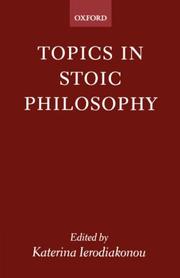
ISBN: 019924880X 0198237685 9780199248803 Year: 1999 Publisher: Oxford : Clarendon Press,
Abstract | Keywords | Export | Availability | Bookmark
 Loading...
Loading...Choose an application
- Reference Manager
- EndNote
- RefWorks (Direct export to RefWorks)
Stoics --- Ethics --- Philosophy, Ancient --- Philosophes du Portique --- Philosophes stoïciens --- Philosophie du Portique --- Philosophie stoïcienne --- Portique (Philosophie grecque) --- Portique [Le ] (Ecole philosophique ancienne) --- Stoa (Filosofische school) --- Stoïciens --- Stoïcijnen --- Stoïcisme (Philosophie grecque) --- École du Portique --- École stoïcienne --- Stoics. --- Philosophy, Ancient. --- Stoïcisme
Book
Abstract | Keywords | Export | Availability | Bookmark
 Loading...
Loading...Choose an application
- Reference Manager
- EndNote
- RefWorks (Direct export to RefWorks)
Philosophy --- Musonius Rufus, Caius --- Philosophes du Portique --- Philosophes stoïciens --- Philosophie du Portique --- Philosophie stoïcienne --- Portique (Philosophie grecque) --- Portique [Le ] (Ecole philosophique ancienne) --- Stoa (Filosofische school) --- Stoïciens --- Stoïcijnen --- Stoïcisme (Philosophie grecque) --- École du Portique --- École stoïcienne --- Stoics
Book
Year: 1979 Publisher: Paris : Diffusion de Boccard,
Abstract | Keywords | Export | Availability | Bookmark
 Loading...
Loading...Choose an application
- Reference Manager
- EndNote
- RefWorks (Direct export to RefWorks)
Delos (grece) --- Delos (grece) --- Portique des naxiens --- Monument aux hexagones
Image
Abstract | Keywords | Export | Availability | Bookmark
 Loading...
Loading...Choose an application
- Reference Manager
- EndNote
- RefWorks (Direct export to RefWorks)
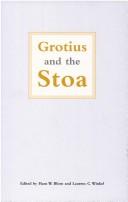
ISBN: 9023240391 9789023240396 Year: 2004 Publisher: Assen Royal Van Gorcum
Abstract | Keywords | Export | Availability | Bookmark
 Loading...
Loading...Choose an application
- Reference Manager
- EndNote
- RefWorks (Direct export to RefWorks)
Until recently, Hugo Grotius has been conspicuously absent in studies of the revival of Stoic philosophy in the 16th and 17th centuries. Dominant models of Neo-stoicism have emphasised the aesthetic and literary innovations, or the bureaucratic applications of the works of Seneca and Tacitus. The moral, legal and political forms of Stoicism in the formative years of the Westphalian System have still to be acknowledged, as goes for the presence of Stoicism in its most innovative intellectual representative: Hugo Grotius (1583-1645). Hugo Grotius’s lasting contribution comes under three headings. He gave the laws of nature a sure footing in the new international order. He pleaded for the uncovering of universal concepts of common human understanding, which formed the basis for his ecumenical endeavours. Thirdly, Grotius was aware of the limited powers of man, given the determination and order of the world. Together, these three intellectual stances are definitely Stoic, and they illustrate the importance of Stoic philosophy in the early Dutch republic. Grotius, nonetheless, is not a Stoic philosopher, if only because he eschewed ‘isms’, and portrayed himself as an eclectic, bringing together the common wisdom of mankind, that on which the schools of philosophy agree, rather than allying himself dogmatically. Within this eclecticism, however, Stoicisms loom large. This book is about these Stoicisms within Grotius’ thought. It is written by specialists on Grotius’ thought and on intellectual and legal history and political thought of the sixteenth to eighteenth centuries. The volume traces the development of Neo-stoicism through Justus Lipsius and its further fate in the writings of Grotius, his contemporaries and his followers.
Thematology --- Grotius, Hugo --- Droit naturel --- Law of nature --- Natural law --- Natural rights --- Nature [Law of ] --- Natuurrecht --- Philosophes du Portique --- Philosophes stoïciens --- Philosophie du Portique --- Philosophie stoïcienne --- Portique (Philosophie grecque) --- Portique [Le ] (Ecole philosophique ancienne) --- Recht [Natuur] --- Rights [Natural ] --- Stoa (Filosofische school) --- Stoicism --- Stoics --- Stoïciens --- Stoïcijnen --- Stoïcisme --- Stoïcisme (Philosophie grecque) --- École du Portique --- École stoïcienne
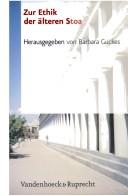
ISBN: 352530143X Year: 2004 Publisher: Göttingen Vandenhoeck & Ruprecht
Abstract | Keywords | Export | Availability | Bookmark
 Loading...
Loading...Choose an application
- Reference Manager
- EndNote
- RefWorks (Direct export to RefWorks)
Ancient ethics --- Antieke ethiek --- Ethics [Ancient ] --- Ethiek [Antieke ] --- Ethiek van de Oudheid --- Ethique de l'Antiquité --- Philosophes du Portique --- Philosophes stoïciens --- Philosophie du Portique --- Philosophie stoïcienne --- Portique (Philosophie grecque) --- Portique [Le ] (Ecole philosophique ancienne) --- Stoa (Filosofische school) --- Stoicism --- Stoics --- Stoïciens --- Stoïcijnen --- Stoïcisme --- Stoïcisme (Philosophie grecque) --- École du Portique --- École stoïcienne --- Ethics, Ancient. --- Stoics. --- Ethics, Ancient --- Ethics --- Philosophy, Ancient
Book
ISBN: 0521779855 052177005X 9780521779852 9780521770057 9780511998874 Year: 2003 Publisher: Cambridge Cambridge university press
Abstract | Keywords | Export | Availability | Bookmark
 Loading...
Loading...Choose an application
- Reference Manager
- EndNote
- RefWorks (Direct export to RefWorks)
Philosophes du Portique --- Philosophes stoïciens --- Philosophie du Portique --- Philosophie stoïcienne --- Portique (Philosophie grecque) --- Portique [Le ] (Ecole philosophique ancienne) --- Stoa (Filosofische school) --- Stoïciens --- Stoïcijnen --- Stoïcisme --- Stoïcisme (Philosophie grecque) --- École du Portique --- École stoïcienne --- History of philosophy --- Antiquity --- Stoics. --- Stoïcisme --- Stoics --- Stoïcisme. --- Ethics --- Philosophy, Ancient
Book

ISBN: 2735126366 Year: 2021 Publisher: Paris : Éditions de la Maison des sciences de l’homme,
Abstract | Keywords | Export | Availability | Bookmark
 Loading...
Loading...Choose an application
- Reference Manager
- EndNote
- RefWorks (Direct export to RefWorks)
Grâce aux fouilles conduites par H Kerèbel. Fanum Martis, actuel Corseul, se dévoile peu à peu. Sur la réserve archéologique de Monterfil II, un vaste ensemble commercial et artisanal a été mis au jour, sur près de 5000 m2, le long d’un axe majeur du chef-lieu de la cité des Coriosolites. Il a ainsi été possible de suivre, de 15/10 av. n è. au IVe s. ap., l’évolution architecturale et topographique du quartier. Le mobilier recueilli, comptant une grande proportion d’estampilles italiques et d’amphores de Lipari, atteste que la cité fut un important marché où s’échangeaient des produits d’origine méditerranéenne. L’étude des vestiges est étayée par une analyse métrologique, menée par un architecte archéologue, qui a notamment permis la restitution des élévations régies par l’ordre toscan. Si Corseul offre encore un vaste champ d’investigations possibles, la fouille de Monterfil II précise désormais comment furent mis en place, sous le règne d’Auguste, le parcellaire urbain et les emprises des domaines public et privé. Under the direction of H. Kértbel, excavation on the site of Fanum Martis. present-day Corseul, has gradually revealed a vast trading and crafts centre within the archaeological protection area of Monterfil II. Uncovering a surface area of over 5000 m2 along the major axis of the former Coriosolati capital has enabled archaeologists to discern architectural and topographical changes which took place in this quarter from 15/10 BCE to the 4th century CE. The finds, which include a high proportion of Italian potters’ marks and Lipari amphorae, attest to the significance ot the town as a marketplace for items produced throughout the Mediterranean Basin. A metrological analysis of the remains, earned out by an archaeologist trained in architecture, has served as the basis for a reconstruction of elevations governed by the Tuscan order. Although there is still much work to be done in Corseul. the excavation carried out thus far at Monterfil II has shown…
Archaeology --- basilique --- gallo-romain --- Armorique --- domus --- chef-lieu de cité --- quartier commercial --- rues --- bâtiment à portique
| Listing 1 - 10 of 44 | << page >> |
Sort by
|

 Search
Search Feedback
Feedback About
About Help
Help News
News